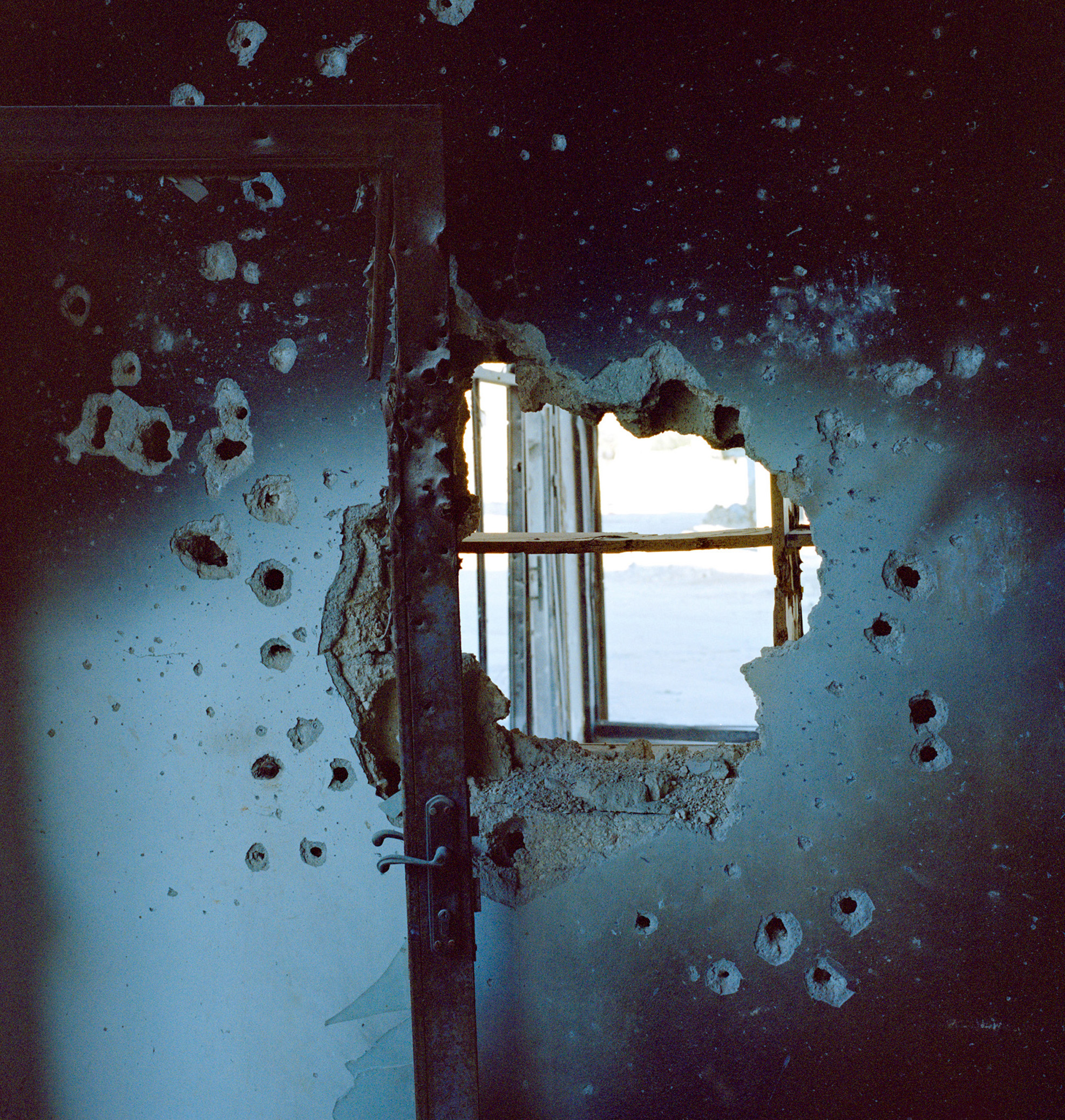4,353 Total views, 2 Views today
By Dr. Özlem Belçim Galip
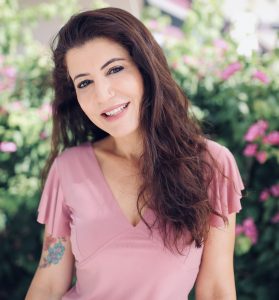
I must admit, when I first had the book entitled “In the Shadow of History” (1997) in my hands in London in 2006, a book of ethnographic photographs and western archives on Kurds in Iraqi Kurdistan reflecting the damaging impacts of the Gulf War (1991) by American photojournalist Susan Meiselas, I was amazed by the size and paper quality of this gigantic book with its very cool hardcover. Apart from Meiselas’ own photos, the book also contained archival material such as images and texts by Western travellers, missionaries, military officers, and colonial administrators. The sense of Kurds, my ancestors, being recorded by someone, especially by a woman, who bothered to have it published in this quality edition, felt fascinating at that time. Without hesitating for a second, I said I had to have a copy of it. It is now in my library, among many others on Kurds written by Western anthropologists and historians.
Meiselas’ view of Kurds and Kurdistan, from her camera/lens and many other Western writings on Kurds and Kurdistan, created in my own imagination a picture of my national and cultural identity and the regions of my own country that I had no access to back then. But she/they did have, somehow, for various reasons. I confess it took me a while to see how these productions of discourse, knowledge, and understanding on Kurds have been created through the lens of Euro- American hegemony, producing a monolithic interpretation that leaves out the authentic Kurdish voice.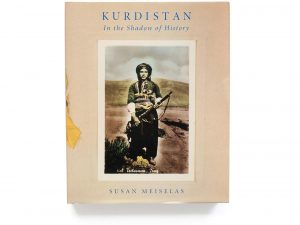
Whenever “In the Shadow of History” catches my eyes now, I feel a big punch on my belly, one of these punches that comes when you least expect it. My initial feeling of amazement has been replaced with frustration and a strong urge to decolonize scholarship on Kurds and Kurdistan. 15 years after I bought “In the Shadow of History,” I can affirm that one of the intellectual impacts of colonialism is, without doubt, the unified narrative of ‘other.’ In the Kurds’ case, this involves highlighting feudalism and patriarchy, wars, conflicts, and stereotypical imagery of rurality which does not allow for a living and thriving culture to move forward. Likewise, the reductive privileging of a non-Kurdish voice and authority in documentary and anthropological photography creates some sort of visual equivalent to the ‘collective arrangement of utterance’ defined by Deleuze and Guattari in 1993 in respect of minor literature, to supposedly represent the entire membership of a group as if the group members are incapable of creating their’ collective utterance’ by themselves. Non-Kurds usually speak for Kurds, a phenomenon that started with a curiosity to explore the Middle East in much greater depth. 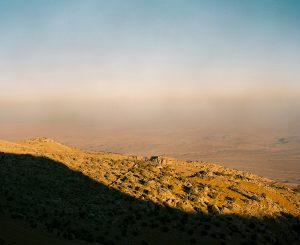
Meiselas’ own photos of Kurds and Iraqi Kurdistan in the book are, in fact, products of a brief period of time, arising out of curiosity about Kurds at the time of the outbreak of the 1991 Gulf War and reflections on the war in the USA. The texts and images are portrayed as fragments, as she says, glimpses of stigmatized symbols such as war, gun, and tribal life, the naivety of rural life. For Tagg (1988:4), “what makes a photograph real is the fact that the photograph is more than merely print and paper[…] what is real is not just the material item, but also the discursive system of which the image bears its part”.
Accordingly, on the book’s cover, a Kurdish tribesman with a rifle in his hand looking out fiercely, manifests himself. To give the readers the female side of these harsh lands, feeding the western curiosity towards the ‘other,’ she also includes in the book a black and white photo of a Kurdish woman with a rifle on her shoulder and a hidden smile on her face. Accordingly, by adopting the role of ‘white savior’ as a young, white, and American cis woman, Susan Meiselas also reproduces the existing family photos of the local Kurds that she met during her Kurdistan visit. She uses a polaroid system to distort their authenticity as personal photos through manufacturing processes for the sake of the so-called preservation of Kurds’ collective memory. In one image on her website (www.susanmeiselas.com), one can see her developing and processing the polaroid film with the help of a translator who shows her the local audience, especially children, sitting and watching her with wonder while she is doing the job. The photo itself conveys the message that the task of recording the collective memory and history of local Kurds will be forgotten without the intervention of a Western photographer who came for a short visit. However, everything has a price, including the recording and documentation of Kurds’ cultural legacy and collective memory by non-Kurds with white privileges.
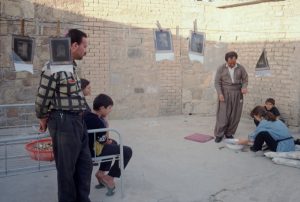
The price is the hierarchy of knowledge production that erases and silences originating cultures. However, Kurds from various cultural, academic, and artistic disciplines, both in Kurdistan and its diaspora, have taken the initiative to create a decolonialized version of Kurdish history and identity, free from typical Western categorization and hegemonic discourse.
“Photography is not only a locus of the production of meaning, but a locus for the production of knowledge for the colonised as much as the coloniser” says scholar and activist Stephen Sheehi.[2] Although not formally declared a ‘colony’, as it was divided between four modern states (Iran, Iraq, Syria and Turkey) under the French and British mandate following World War I, Kurdistan is seen as an ‘international colony’ (Besikci).[3] The continuity of colonial forms of domination not just in terms of geopolitical territory but also in media, culture and art is not necessarily linked with the end of direct colonial administrations or settler colonialism. ‘The coloniality of power’ (Quijano) remains in every aspects of the subaltern’s life and prioritizes the use of a Eurocentric system of knowledge and fundamentalism. It is not only territorial; it is a way of thinking, a mode of desiring, a set of relations.[4] Photography is already developed on the basis of already existing imperial practices, structures and regimes that it continues to reproduce regardless of gender in the nexus of coloniality of power and knowledge. In the case of Susan, although she first attracted my attention because of her gender, being a female photographer does not make much difference to her practice relative to that of Western male counterparts (e.g. Sebastian Meyer, Paul Maubec, known by his pen name Chris Kutschera) in terms of her capture of Kurds and Kurdistan being shadowed by Eurocentric and colonial thinking.[5] Visual capture of Kurds and Kurdistan, like anthropological works mainly undertaken by American and European male ethnographers and historians, has hitherto adopted Western stereotypes of power, representing it as non-existent, with subjects deprived of agency in their everyday practices or else totally politicized. The strong sense of kinship, patrilineal ideology and tribal linkages are emphasized, and the visual portrayal of Kurdish society in general has affected the portrayal of the gender system, which is depicted as a rigid one in which men are strictly masculinized and women are feminized in sketchy if not inaccurate pictures of the situation of Kurdish women. The materials are also very selective.
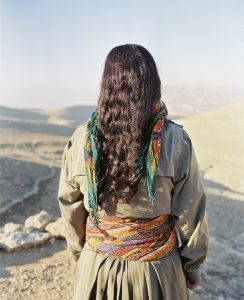
In the political situation in the context of neo-colonialism, the key to understanding and criticizing the Western photographers is the norm they use for evaluating ‘power’, ‘autonomy’ and ‘agency’ at individual or collective level, taking the their own status in their own community as an ideal to be thrust upon other communities, which creates the understanding of the photographer as the ‘parent’ and those photographed as ‘children’ in a desparate situation who need to be taken care of or taught. Susan Meiseles stands as a parent in her every shot. She either shows the brutality of poverty and suffering (e.g. mass Kurdish graves resulting from Saddam Hussein’s 1988 Anfal Campaign, a campaign of mass annihilation) or the pure enjoyment and curiosity of locals on the streets when she introduces them to photography. Alongside her parenting position, she misses the grey areas while concentrating solely on two reductionist depictions in her collection. First, the local Kurds are suffering; secondly, they do not know much about photography. In fact, showing the process of photography, a Western invention indeed, and one of “imperial technologies of extraction, conquest, control, and dehumanization”,[6] serves the West’s Eurocentric purpose of extending its sphere of influence through ‘civilizing’ the Orient. Overall, Susan’s photographs on the impacts of Saddam’s war on Kurds, with their documentary quality, produce the ‘knowledge’ and ideology by themselves without leaving any space for interpretation or the imagination of the audience. For instance, amongst her In the Shadow of History collection, we see a 15-year-old Kurdish boy, saved by a well-known tribesman who points out his wound, which was inflicted during mass killing by Iraqi army units in 1989, to the camera. The caption underneath the photo tells his tragic story in a disquieting manner, putting the spectators into a very passive position. What is possibly most disturbing is that the boy’s wounded body is seen as ‘free raw material’ (even before considering that he is also underage) that Susan thinks she has the right to use, accumulate and put in her archive to display in her virtual exhibition and pricy hardcopy book. Susan’s photographs, like her western male counterparts, show “the process of primitive accumulation of wealth (especially visual wealth), labour, and resources” under imperial power.[7]
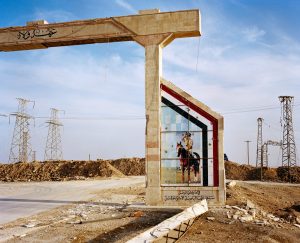
Sonja Hamad, a Kurdish Yazidi documentary photographer who migrated to Germany with her family when she was a child, is undoubtedly one of the main Kurdish woman artists to highlight the need for a contemporary approach to developing a counter-narrative to the visual expressions of the colonialized territories of Kurdistan by Western anthropological photographers such as Susan Meiselas. Starting out with a classic documentary style but tending towards a more essayistic and artistic mode, with her personalized voice reflected in the collection of her works and exhibitions on Kurds after several in-depth visits to Kurdistan, Sonja initiates questions on colonially-forged visual narratives about Kurds by exploring her own authentic art form and multi- dimensional identity. She interprets her works as an artistic exploration of the present postcolonial Kurdistan, her personal story, and her connection to the cultural heritage of Kurdish territories as a Yazidi follower of an ancient monotheistic faith.

That one’s life can be the material for a work of art is not a new idea. But Sonja’s artistic products and plans are the material signs of a more fundamental process of self-identification, not just for herself but for Kurdistan in general. She reimagines different aspects of the Kurds and their everyday lives from an anti-colonial and deeply nuanced perspective. Hamad offers a visual narrative of Kurdistan through a decolonizing documentary and aesthetic mode, and she is keen to pursue this plan in a very systematic way. For instance, she set herself a 10-year plan to complete a comprehensive photography project on Kurdistan. The first chapter of this plan was “Jin, Jîyan, Azadî” (Women, Life, Freedom), sponsored by VG Bild-Kunst, showing a total of 26 photographic portraits of Kurdish women fighters combating ISIS and other opposing groups in both Syria and Iraq, as well as landscapes of Kurdistan. First published by ZEIT magazine, the photographs were taken in eight Iraqi and Syrian Kurdistan locations. With its sound installation of the fighters’ chants, this project has been exhibited in various cities and received the third prize at “The Rencontres of Arles,” the best-known international photo festival, which takes place in Arles in the South of France. She explains her choice of Kurdish women fighters as the subject of the first chapter of her series: “the Kurdish woman fighter is not only regarded as a threat to Sunni masculinity but has also been exoticized among German society. However, this simply does not bring a real belonging; it is actually a distorted image, an illusion of her”. With her photographs, contrasting their representation in mainstream media outlets and popular culture, Sonja offers complex and diverse subjectivities of the Kurdish women combatants. Trinh T. Minh-ha (1989) and Judith Butler (1990) have both argued that disunified and multiplied subject positions created through difference offer potential sites for liberation. Accordingly, considering the diverse portrayals of women fighters in her project, Sonja not only strives to liberate Kurdish women fighters but Kurds in general, captivated by Eurocentrism as a hegemonic structure of knowledge and belief.
Sonja Hamad’s project “Jin, Jîyan, Azadî” (Women, Life, Freedom), can be considered as a counterargument against widespread reductionist and one-dimensional portrayal of Kurdish women fighters against the Jihadist Islamic group ISIS in the global media. On the one hand these women are depicted as suffering and strife-torn, on the other they are valorised with heroic and exotic attributes in Western mainstream media. While objectivity is an intrinsic property of photography, Susan Sontag in her book-length essay “Regarding the Pain of Others” (2003) argues that images are always produced with a point of view. Accordingly, instead of showing horrific and shocking war photographs, she set her camera (point of view) in a humanizing setting and goes beyond the mainstream representation of women fighters presenting dehumanised accounts. She presents a radical departure from the convention of binary thinking about women combatants, as either ‘victimized’ or ‘empowered’ and smashes the stereotype that armed resistance is just about bearing weapons or being involved in political and military actions, as well as the common idea that involvement with a group inevitably compromises one’s individual artistic and creative perspective.
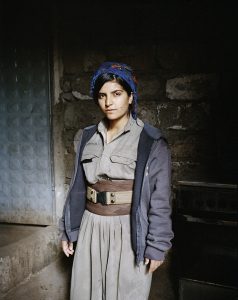
Although her collection of “Jin, Jiyan, Azadî” heavily centres on the Kurdish women guerrillas’, the images are not as politicised as one expects. The impact of ongoing war is immersed with the object and settings she captures not just fighters, for instance, the wall full of bullet holes, the colourful scarf of the women guerrilla, the destructed hospital under the dust with explosive attack of ISIS or the simplicity and care in the dining table set by the fighters even at the time of the war and death, or the solitude of weapons leaning against the walls. Her artistic expression through spirituality, beauty and nature complicating mainstream Western conceptions of art and aesthetics. Sonja does not authorize herself as a narrator (or parent) like Meiseles; instead, through her photographs, she is seeking to centre the experiences, stories, and realities of the fighters and locals in their own contexts which have been either dismissed or misrepresented by her Western counterparts. Sonja approaches Kurdistan beyond a territorialised geography but more like a spiritual place and ancestral place in the manner of “indigenous aesthetic” that developed independently of the Western tradition of Middle East, that orientalist power-knowledge nexus as an ahistorical space.[8] A “profound sense of place” connecting the “spiritual with the natural” is central to Indigenous aesthetics (Ibid.). Accordingly, in her project “On the Road to Kurdistan”, Sonja focuses the authentic features of Kurdish topography, valleys, and mountains, as the topography of Kurdistan is quite distinctive, and its mountainous scenery is often emphasized in Kurdish cultural and folkloric materials. The connection to place, to the sacred and to the nature created and preserved in her photographs in the form of cultural continuity is a crucial part of her contemporary art practices.
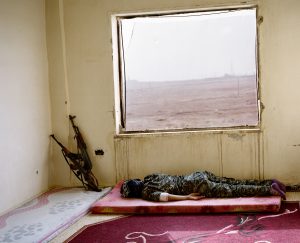
The next group of Kurds which Sonja turns her attention to is the Yazidis. Her new project titled “Lamento” addressing Yazidi lamentations, was inspired by the Sinjar massacres by ISIS of thousands of Yazidi men, women, and children in 2014 in Shengal, Iraqi Kurdistan. The Yazidi massacres, constituted as genocide by UN in May 2021, started with the attack and capture of Sinjar on 3rd August 2014 during its Northern Iraq invasion, continued throughout August 2014. Yazidi men were killed, mainly those refusing to convert to Islam, women were abducted and forced into sex slavery. It is estimated that there have been up to four thousand deaths and ten thousand abductions of women and children, two hundreds of thousands of locals have been displaced.
Sonja exclusively selected Yazidi laments because she sees lamentations as performative acts in which themes including life, exile, diaspora, grief, and death vary in ways that cover life from different perspectives. Her artistic method and vision show that, by combining socio-political and aesthetic perspectives, Yazidi laments conveying significant sacred myths, stories, and cultural elements transmitted over generations, become a crucial site of distinctive voice and self-remaking. This is true not just for her but for all Yazidi Kurds who have experienced massacres and forced displacement due to their faith throughout the last century.
In a parallel to how Simone de Beauvoir (1997) sees the condition of women on the margins of society, like a war correspondent reporting from the edge of the battlefield (close to but not amid things) as a space of possibilities, Germany as the ‘exilic space’ has also opened up possibilities for Sonja to look at her stateless country. This has provided an enriched and broad perspective from which to challenge the systematic silencing and reduction of Kurds to stereotyped and victimized tabloid caricatures.
Her counterargument is not only against the way Kurds are visually narrated by Western documentary or anthropological photographers but also the way she, as a non-native of Germany, is being posited in the contemporary discourse.
While she believes that the “existential discomfort” that migrants need to overcome in order to learn “to speak” in a white world means that they require a lot of courage and struggle to be able to become visible and be seen independently of ‘white’ projections, she does not see herself as a ‘migrant.’ To her, as someone born in Syrian Kurdistan and raised in Germany, being put in the category of a migrant in Europe is not only a very narrow but also a very misleading way to define her. Her transnational hybrid subjectivity goes beyond the category ‘migrant,’ as this conveys very static connotations such as ‘uncertain citizen’ and refers to a temporary position in a fixed location. Instead, she employs a more Deleuzian-inspired deconstruction of identity and subjectivity whereby she continuously disrupts the narratives of the centralized power structure through counter-narratives and subversive expressions in her art.
If she experiences side-lining in the mainstream discourse, this is not because of her non-white or migrant past but due to the fluid variations that exist in her cosmopolitan existence, whose art is a discursive space for marginalized voices to dismantle the conservative structures in the art world alongside her fellow artists. In this sense, Sonja interprets the works of artists, not necessarily with migrant backgrounds, who name the problems or power structures in Germany and in the western world generally, as “subaltern voices and subaltern practices,” bringing us back to the question that Gayatri Spivak posed many years ago, “Can the subaltern speak?” (1988).
Sonja believes that, in the context of Germany, ‘subalterns’ tell, produce, and document their own stories in order to resist “internalized colonialism.” In fact, Spivak does not see migrants or those who find themselves marginalized for whatever reasons in Europe as ‘subaltern,’ she thinks they have the agency to raise their voice. However, one cannot avoid countering this view by questioning whether, given the nature of established power relations, those with strong affiliation to Eurocentric scholarship offer the marginalized the same chance of voicing themselves as those with white privilege.
Özlem Belçim Galip is a Research Fellow at the Institute of Social and Cultural Anthropology at the University of Oxford. She is the author of Imagining Kurdistan: Identity, Culture and Society (I.B, Tauris, 2015) and Civil Society versus State: New Social Movement and Armenian Question in Turkey (Palgrave, 2020). She is currently at the postproduction stage of her ethnographic documentary film “Anywhere on this Road: Letters to My Unborn Daughter” on Kurdish intellectual women in Europe and her own personal journey as a Kurdish woman migrant, shot in various cities in Turkish Kurdistan along with Germany, England, and Sweden.
[1] “Peacock Angel” (Melek Taûs), is one of prominent figures for Yazidi faith.
[2] Stephen Sheehi, “Decolonising the Photography of Palestine: Searching for a Method in a Plate of Hummus”. In Imaging and Imagining Palestine edited by Karène Sanchez Summerer and Sary Zananiri (Brill, 2021).
[3] Iraqi Kurdistan is unique among the regions of Kurdistan in having de facto autonomy, being officially governed by the Kurdistan Regional Government (KRG) since 1991. Besikci, Ismail. International Colony Kurdistan (Gomidas Institute, 2016).
[4] Aníbal Quijano, “Coloniality of Power, Eurocentrism, and Latin America,” Nepantla: Views from South 1, no. 3 (2000): 533–580.
[5] Digital archive of the photos on Kurds and Kurdistan, see https://kurdistan.photoshelter.com. Kurdish photographer Murat Yazar, living in Italy, only taking monochrome, has an extensive project on Kurdistan conveying his diverse artistic visions and emotions with the help of different themes, images and subjects from rural landscapes to picturing both mourning and celebrations. See, https://www.muratyazar.info. He also published a book based on the exhibition with the title Shadows of Kurdistan. A photographic research of a cultural identity in 2020.
[6] Stephen Sheehi, “Can we unlearn imperialism? Ariella Azoulay offers methods and lessons,” Hyperallergic (25 August 2020). Available at: https://hyperallergic.com/583885/potential-history-review-ariella-azoulay/
[7] Interview with Azoulay by Sabrina Alli, “It is not possible to decolonize the museums without decolonizing the world,” Guernica (12 March 2020). Available at: https://www.guernicamag.com/miscellaneous-files-ariella-aisha-azoulay/
[8] Steven Leuthold. 1998. Indigenous Aesthetics: Native Art, Media, and Identity.

